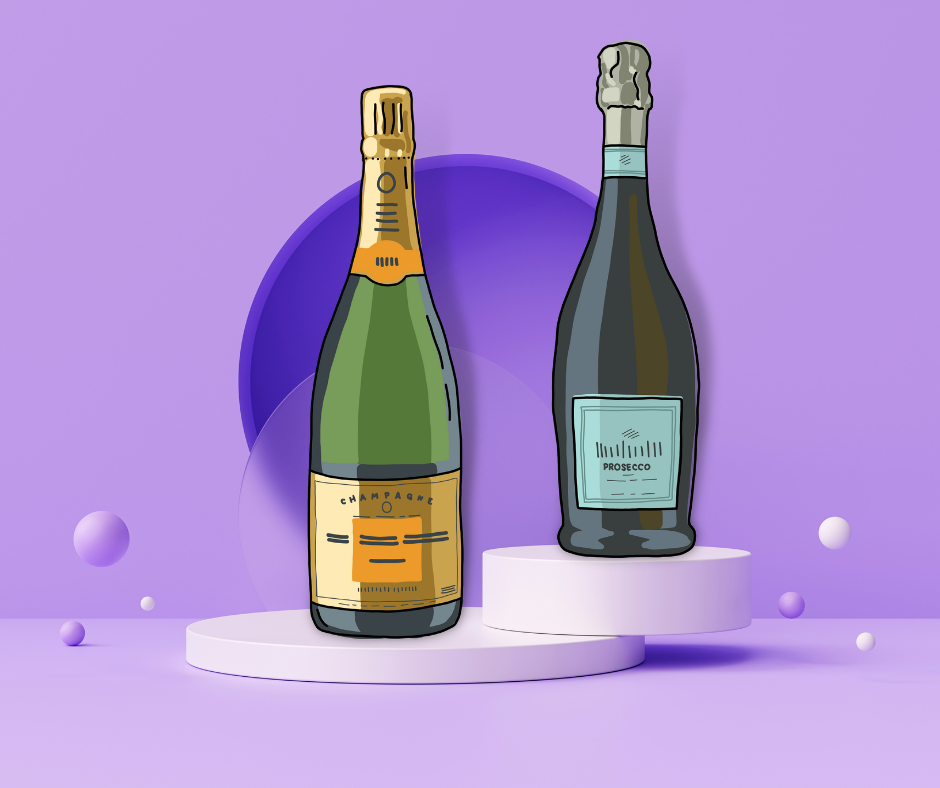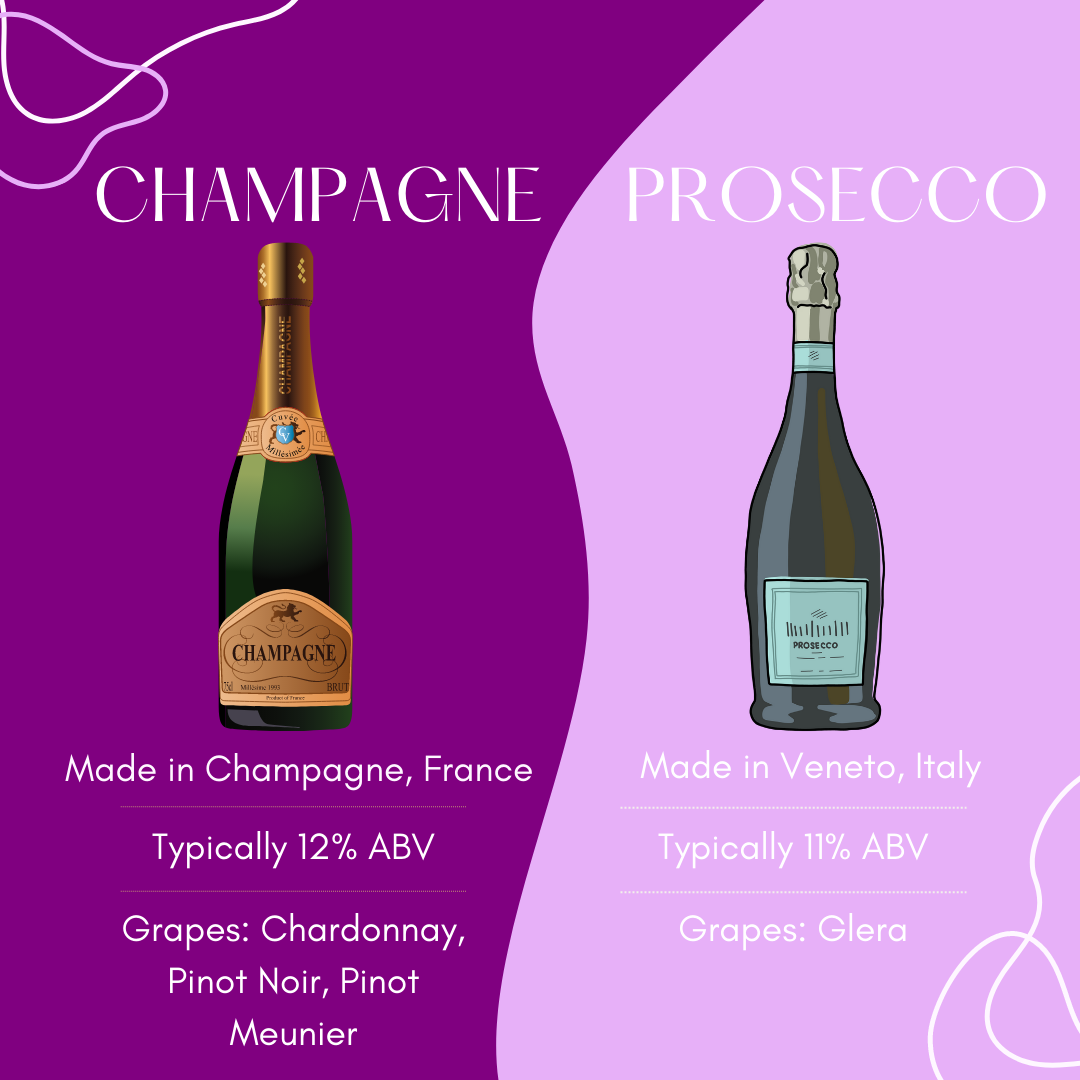
If you’re like me, you may use the terms “Prosecco” and “Champagne” interchangeably. Truth be told, it doesn’t really bother me, but the more I become obsessed with all different types of Prosecco, the more I wanted to learn about the actual differences between the two. And it’s more than just the price!
I’ve researched this topic, consulted with some bubbly experts (a title I’m coining), and even put together some little cheat sheets to help y’all understand the differences (and even the similarities) so you can use the correct terminology around your friends, you know, if you actually care. I’m still on the fence.

Champagne vs. Prosecco Guide
WHAT'S THE REAL DIFFERENCE BETWEEN PROSECCO AND CHAMPAGNE?
If you ever researched this, you’ll always find the same differentiator between champagne and Prosecco. And here it is:
Sparkling wine can only be called Champagne when it strictly comes from the region of Champagne, France. Prosecco, on the other hand, typically comes from the region of Veneto, Italy."
So there you have it. It really all has to do with the location. So, unless your sparkling wine of choice isn’t actually made in the Champagne region of France, you really should stop calling it Champagne. Personally, I’m sure I’ll still call it that, but that’s just me.
There are actually some additional differences worth noting as well.
DIFFERENCES IN THE PRODUCTION METHOD
One of the most significant differences between Champagne and Prosecco is the production method used to make each wine. Champagne is made using the traditional method, also known as the méthode champenoise. This involves a secondary fermentation process that takes place inside the bottle, which creates the carbonation and gives Champagne its signature bubbles. The wine is then aged on the lees (dead yeast cells) for a period of time to develop its complex flavors and aromas.
Prosecco, on the other hand, is made using the Charmat method (also known as the tank method). In this process, the secondary fermentation takes place in large tanks, rather than individual bottles. This results in a wine that is less complex than Champagne, but still has a refreshing and lively effervescence.
DIFFERENCES IN THE GRAPE VARIETIES
Another key difference between Champagne and Prosecco is the grape varieties used to make each wine. Champagne is made using three grape varieties: Chardonnay, Pinot Noir, and Pinot Meunier. Each of these grapes contributes different flavors and characteristics to the wine.
Prosecco, on the other hand, is made using primarily one grape variety: Glera. While other grape varieties are sometimes used in the production of Prosecco, Glera is the primary grape and is responsible for the wine’s fresh and fruity taste.
DIFFERENCES IN THE TASTE
Believe it or not, there actually is a difference in the taste profile between Champagne and Prosecco. The different taste profiles really do set them apart.
Typically, Champagne is known for its complex and layered flavors, which can include notes of citrus, apple, pear, and brioche. The wine is often characterized by its high acidity and subtle minerality, which gives it a crisp and refreshing finish.
Prosecco, on the other hand, is known for its light and fruity taste. The wine is often described as having flavors of green apple, peach, and citrus, with a refreshing acidity and lively effervescence.
I recently reviewed LaMarca Prosescco here, if you’re interested in learning more.
DIFFERENCES IN THE BUBBLES THEMSELVES
The bubbles in Prosecco and Champagne are actually different due to their production methods.
In Champagne, the traditional method of production involves a secondary fermentation process that takes place in individual bottles. During this process, yeast and sugar are added to the wine, which produces carbon dioxide and creates the bubbles. The wine is then aged on the lees for a period of time, which gives it a creamy and fine mousse bubbles.
Prosecco, on the other hand, is made using the Charmat method (also known as the tank method). In this process, the secondary fermentation takes place in large tanks, rather than individual bottles. As a result, the bubbles in Prosecco are larger and less persistent than those in Champagne. Prosecco is also typically less complex than Champagne, which means that its bubbles are often described as being more playful and lively.
In terms of carbonation level, Champagne tends to have a higher level of carbonation than Prosecco. This is due to the longer aging process and the higher pressure in the bottle during secondary fermentation. The bubbles in Champagne are also known for being smaller and more persistent than those in Prosecco.
WHICH IS USUALLY MORE EXPENSIVE?
When all factors are typically equal, Champagne is usually more expensive than Prosecco due to a combination of factors, like the production process, grape varieties used, and the region of origin (all listed above).
As mentioned earlier, Champagne is made using the traditional method of secondary fermentation in individual bottles, which is a more labor-intensive and time-consuming process than the tank method used to produce Prosecco. This results in higher production costs, which are reflected in the price of the wine.
In addition, Champagne is made using three grape varieties: Chardonnay, Pinot Noir, and Pinot Meunier, which can be more expensive than the Glera grape used in the production of Prosecco. Champagne is also produced in a specific region of France, the Champagne region, which has strict regulations and standards for wine production. These regulations contribute to the exclusivity and prestige of the Champagne brand, which in turn affects its price.
On the other hand, Prosecco is made primarily using the Glera grape and is produced in the Veneto region of Italy. The production process is less expensive, and the regulations and standards for wine production are less strict than those for Champagne, which allows for a wider range of producers and price points.
Of course, the price of both Champagne and Prosecco can vary depending on factors such as the producer, vintage, and specific bottling. However, in general, Champagne tends to be more expensive than Prosecco due to its production process, grape varieties used, and region of origin.
THE BOTTOM LINE
In conclusion, while Champagne and Prosecco are both sparkling wines, they have many differences that set them apart. From the production method to the taste profile, these two wines offer unique and distinct experiences for wine lovers around the world. Whether you prefer the complex and layered flavors of Champagne or the light and fruity taste of Prosecco, both wines are perfect for celebrating life’s special moments.
